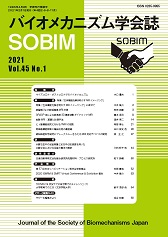All issues

Volume 45, Issue 4
Displaying 1-9 of 9 articles from this issue
- |<
- <
- 1
- >
- >|
Reviews
-
[in Japanese]2021Volume 45Issue 4 Pages 208
Published: 2021
Released on J-STAGE: November 25, 2022
JOURNAL FREE ACCESSDownload PDF (1251K) -
[in Japanese]2021Volume 45Issue 4 Pages 209-214
Published: 2021
Released on J-STAGE: November 25, 2022
JOURNAL FREE ACCESS -
[in Japanese]2021Volume 45Issue 4 Pages 215-219
Published: 2021
Released on J-STAGE: November 25, 2022
JOURNAL FREE ACCESS -
[in Japanese], [in Japanese], [in Japanese], [in Japanese]2021Volume 45Issue 4 Pages 220-226
Published: 2021
Released on J-STAGE: November 25, 2022
JOURNAL FREE ACCESS -
[in Japanese], [in Japanese], [in Japanese]2021Volume 45Issue 4 Pages 227-238
Published: 2021
Released on J-STAGE: November 25, 2022
JOURNAL FREE ACCESS
Paper
-
Kohei TSURUSAKI, Shota INOUE, Yoshihiro EHARA2021Volume 45Issue 4 Pages 239-244
Published: 2021
Released on J-STAGE: November 01, 2021
JOURNAL FREE ACCESSCenter of gravity is an important data to assess symmetry and efficiency of human gait.However,usual kinematic method which is a most popular method of calculating the center of gravity have a problem that the calculated the center of gravity does not reflect subject’s characteristic because pre-determined body segment parameters are used for calculation.In this paper,the center of gravity of three trans-femoral amputees were calculated from ground reaction forces,and compared with the center of gravity obtained from the kinematic method.As a result,the center of gravity of trans-femoral amputees obtained from this new method was located on sound side than that obtained from kinematic method.The usefulness of this new method was demonstrated since this results reflected feature of trans-femoral amputees.View full abstractDownload PDF (2176K) -
DANG KHOA NGUYEN, Yuta TOKUNAGA, Tomoya TAKABAYASHI, Takuma INAI, Masa ...2021Volume 45Issue 4 Pages 245-250
Published: 2021
Released on J-STAGE: November 01, 2021
JOURNAL FREE ACCESSThe purpose of this study was to examine the effect of fixed / unfixed knee joint on single-leg standing balance, and to identify those who are considered to have a high risk of ankle re-injuries among people with chronic ankle instability (CAI). We compared the center of pressure (COP) and head and foot accelerations of healthy and CAI groups under the fixed and non-fixed conditions of the knee joint in the single leg standing posture with eyes closed. Based on the changes of the medio-lateral acceleration of head between two conditions, the CAI group was divided into two sub-groups, and the balance ability was evaluated. It became more difficult to maintain the posture with the knee-joint-fixed condition, but expressions were different between two groups. Among the CAI group, those with high head acceleration change seemed to have ankle instability that was masked by movement of hip joint via kinematic chain. Those who showed high change in head acceleration in constrained single-leg standing may have a higher risk of ankle sprain re-injury.View full abstractDownload PDF (2398K) -
Emi ANZAI, Haruna ASANO, Kanako NAKAJIMA, Miyuki KODAMA, Yoshiyuki KOB ...2021Volume 45Issue 4 Pages 251-258
Published: 2021
Released on J-STAGE: November 01, 2021
JOURNAL FREE ACCESSThis study aimed to create models of knee instability using inertial sensors. Seventy older adults, aged 71.2 ± 6.6 years, participated in this study. The acceleration and angular velocity were obtained using inertial sensors placed on the lower limb and five physical therapists assessed the knee instability of the subjects hierarchically. Thirty-nine variables, including the amplitudes of the acceleration, and the angular velocity for each sensor and for the three axes, were extracted. Multivariate ordered logistic regression analysis was performed to identify the factors affecting knee instability in the observational assessment. And the five-graded knee instability assessment models were created using variables that were excluded if they correlated with each other. The results indicated that the increased lateral acceleration [odds ratio (OR) = 3.51, p<0.01] and the decreased vertical acceleration [OR = 0.43, p<0.01] of the distal femur in the stance phase, and the increased angular velocity of the proximal tibia in the stance phase [OR = 1.91, p<0.01] were significant predictive factors for knee instability. This study found that all of the above three indicators were selected in all models driven by stepwise selection in each leave-one-subject-out cross-validation. Therefore, these factors could be used for knee instability evaluation model.View full abstractDownload PDF (3328K)
Series
-
[in Japanese]2021Volume 45Issue 4 Pages 265-271
Published: 2021
Released on J-STAGE: November 01, 2021
JOURNAL FREE ACCESSDownload PDF (3891K)
- |<
- <
- 1
- >
- >|